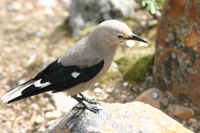|
Nutcrackers |

Nucifraga columbiana
|
|
Scientific classification |
|
|
| Species |
Nucifraga caryocatactes
Nucifraga columbiana |
The nutcrackers (Nucifraga) are a
genus of two species of
passerine
bird, in the family
Corvidae, related to the
jays
and
crows. One, the
Spotted Nutcracker (Nucifraga caryocatactes), occurs in
Europe and Asia, the other, Clark's Nutcracker (Nucifraga
columbiana), in western North America.
The most important food resources for both these species
are the seeds (pine nuts) of various Pines (Pinus sp.),
principally the cold-climate (far northern or high altitude)
species of white pine (Pinus subgenus Strobus) with large
seeds: P. albicaulis, P. armandii, P. cembra, P. flexilis,
P. koraiensis, P. parviflora, P. peuce, P. pumila, P.
sibirica and P. wallichiana, and also the pinyon and
lacebark pines in subgenus Ducampopinus. In some regions,
where none of these pines occur, the seeds of Spruce (Picea
sp.) and Hazel nuts (Corylus sp.) form an important part
of the diet too. The bills of these birds are specialized
tools for extracting seeds from pine cones.
Surplus seed is always stored for later use and it is
this species that is responsible for the re-establishment of
their favoured pines over large areas either burnt in forest
fires or cleared by man.
Various insects are also taken, including bee and wasp larvae, and also birds' eggs and nestlings, and
carrion if it is found.
Nesting is always early in this genus, so as to make the
best use of pine nuts stored the previous autumn. The nest
is usually built high in a conifer. There are normally 2-4
eggs laid and incubated for 18 days. Both sexes feed the
young which are usually fledged by about 23 days and stay
with their parents for many months, following them to learn
food storage techniques.
Neither species is
migratory, but they will erupt out of their ranges if a
cone crop failure causes a food shortage.
Reference
- Lanner, R. M. (1996). Made for each other: a
symbiosis of birds and pines. OUP
ISBN 0-19-508903-0
External links




